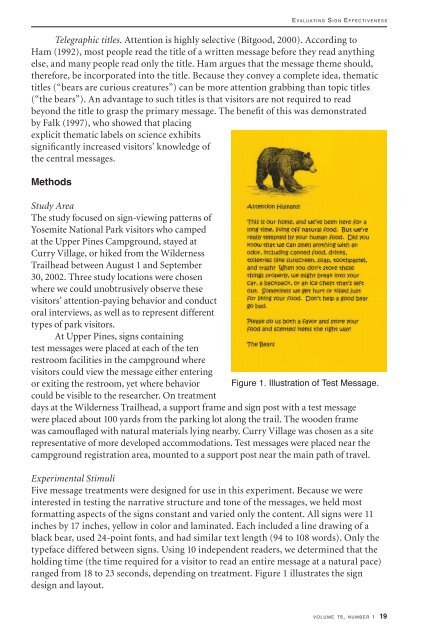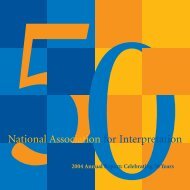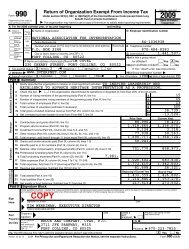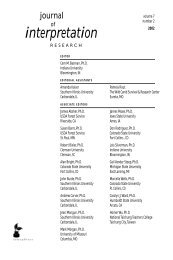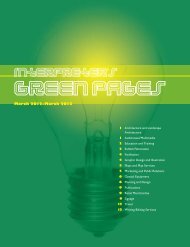interpretation
Volume 15, Number 1 - National Association for Interpretation
Volume 15, Number 1 - National Association for Interpretation
You also want an ePaper? Increase the reach of your titles
YUMPU automatically turns print PDFs into web optimized ePapers that Google loves.
Telegraphic titles. Attention is highly selective (Bitgood, 2000). According to<br />
Ham (1992), most people read the title of a written message before they read anything<br />
else, and many people read only the title. Ham argues that the message theme should,<br />
therefore, be incorporated into the title. Because they convey a complete idea, thematic<br />
titles (“bears are curious creatures”) can be more attention grabbing than topic titles<br />
(“the bears”). An advantage to such titles is that visitors are not required to read<br />
beyond the title to grasp the primary message. The benefit of this was demonstrated<br />
by Falk (1997), who showed that placing<br />
explicit thematic labels on science exhibits<br />
significantly increased visitors’ knowledge of<br />
the central messages.<br />
Methods<br />
Study Area<br />
The study focused on sign-viewing patterns of<br />
Yosemite National Park visitors who camped<br />
at the Upper Pines Campground, stayed at<br />
Curry Village, or hiked from the Wilderness<br />
Trailhead between August 1 and September<br />
30, 2002. Three study locations were chosen<br />
where we could unobtrusively observe these<br />
visitors’ attention-paying behavior and conduct<br />
oral interviews, as well as to represent different<br />
types of park visitors.<br />
At Upper Pines, signs containing<br />
test messages were placed at each of the ten<br />
restroom facilities in the campground where<br />
visitors could view the message either entering<br />
or exiting the restroom, yet where behavior Figure 1. Illustration of Test Message.<br />
could be visible to the researcher. On treatment<br />
days at the Wilderness Trailhead, a support frame and sign post with a test message<br />
were placed about 100 yards from the parking lot along the trail. The wooden frame<br />
was camouflaged with natural materials lying nearby. Curry Village was chosen as a site<br />
representative of more developed accommodations. Test messages were placed near the<br />
campground registration area, mounted to a support post near the main path of travel.<br />
Experimental Stimuli<br />
Five message treatments were designed for use in this experiment. Because we were<br />
interested in testing the narrative structure and tone of the messages, we held most<br />
formatting aspects of the signs constant and varied only the content. All signs were 11<br />
inches by 17 inches, yellow in color and laminated. Each included a line drawing of a<br />
black bear, used 24-point fonts, and had similar text length (94 to 108 words). Only the<br />
typeface differed between signs. Using 10 independent readers, we determined that the<br />
holding time (the time required for a visitor to read an entire message at a natural pace)<br />
ranged from 18 to 23 seconds, depending on treatment. Figure 1 illustrates the sign<br />
design and layout.<br />
v o l u m e 15, n u m b e r 1 19


